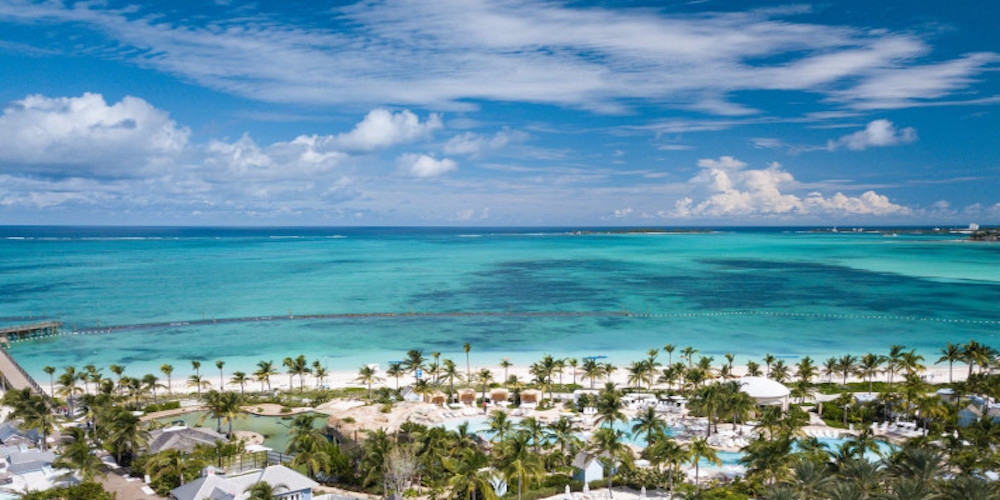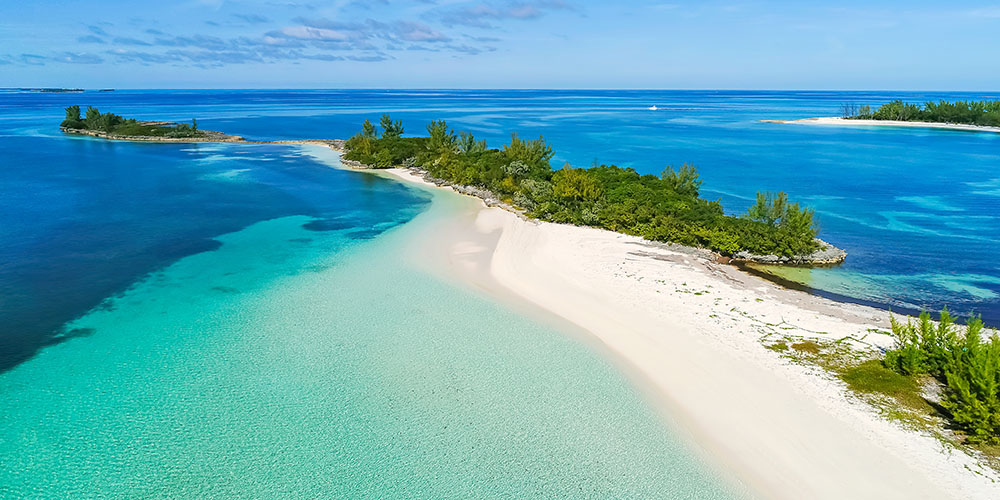The most developed islands for tourism are New Providence, site of Cable Beach and Nassau (the capital); Paradise Island; and Grand Bahama, home of Freeport and Lucaya. If you’re after glitz, gambling, bustling restaurants, nightclubs, and a beach-party scene, these big three islands are where you’ll want to be. Package deals are easily found.
Set sail (or hop on a short commuter flight) for one of the Out Islands, such as Andros, the Exumas, or the Abacos, and you’ll find fewer crowds — and often lower prices, too. Though some of the Out Islands are accessible mainly (or only) by boat, it’s still worth your while to make the trip if you like the idea of having an entire beach to yourself. These are really the places to get away from it all.
New Providence Island (Nassau/Cable Beach)
New Providence isn’t the largest Bahamian island, but it’s the nation’s historic heart, with a strong maritime tradition and the country’s largest population (125,000). It offers groves of palms and casuarinas; sandy, flat soil; the closest thing in The Bahamas to urban sprawl; and superb anchorages sheltered from rough seas by nearby Paradise Island. New Providence also has the country’s busiest airport and is dotted with hundreds of villas owned by foreign investors. Its two major resort areas are Cable Beach and Nassau.

Cable Beach is a glittering beachfront strip of hotels, restaurants, and casinos; only Paradise Island has been more developed. Often, deciding between Cable Beach and Paradise Island isn’t so much a choice of which island you prefer as a choice of which hotel you prefer. But it’s easy to sample both, since it takes only about 30 minutes to drive between the two.
Nassau, the Bahamian capital, isn’t on a great stretch of shoreline and doesn’t have as many first-rate hotels as either Paradise Island or Cable Beach — with the exception of the British Colonial Hilton, which has a small private beach. The main advantages of Nassau are its colonial charm and lower price point. Its accommodations may not be ideally located, but they are relatively inexpensive, sometimes even during the winter high season. You can base yourself here and commute easily to the beaches at Paradise Island or Cable Beach. Some travelers even prefer Nassau because it’s the seat of Bahamian culture and history — not to mention the shopping mecca of The Bahamas.
Paradise Island
If high-rise hotels and glittering casinos are what you want, alongside some of the best beaches in The Bahamas, there is no better choice than Paradise Island, directly off Nassau’s coast. It has the best food, entertainment, hotels, and terrific beaches and casinos. Its major drawbacks are that it’s expensive and often overcrowded. With its colorful history but unremarkable architecture, Paradise Island remains one of the most intensely marketed pieces of real estate in the world. The sands and shoals of the long, narrow island protect Nassau’s wharves and piers, which rise across a narrow channel only 180m (591 ft.) away.
Owners of the 277-hectare (684-acre) island have included brokerage mogul Joseph Lynch (of Merrill Lynch) and Huntington Hartford (heir to the A&P supermarket fortune). More recent investors have included Merv Griffin. The island today is a carefully landscaped residential and commercial complex with good beaches, lots of glitter (some of it tasteful, some of it way too over-the-top), and many diversions.
Grand Bahama Island (Freeport/Lucaya)
The island’s name derives from the Spanish term gran bajamar (“great shallows”), which refers to the shallow reefs and sandbars that, over the centuries, have destroyed everything from Spanish galleons to English clippers on these shores. Thanks to the development schemes of U.S. financiers such as Howard Hughes, Grand Bahama boasts a well-developed tourist infrastructure. Casinos, beaches, and restaurants are now plentiful.
Grand Bahama’s Freeport/Lucaya resort area is another popular destination for American tourists, though it has a lot more tackiness than Paradise Island or Cable Beach. The compensation for that is a lower price tag on just about everything. Freeport/Lucaya offers plenty of opportunities for fine dining, entertainment, and gambling.
This island, especially popular with families, also offers the best hiking in The Bahamas and some of the finest sandy beaches. Its golf courses attract players from all over the globe and host major tournaments several times a year. You’ll find some of the world’s best diving here, as well as UNEXSO, the internationally famous diving school.

Bimini
One of the smallest destinations in The Bahamas, Bimini is close enough to Miami (just 81km/50 miles) to be distinctly separate from the archipelago’s other islands.
Bimini is actually a pair of islands with a total area of 23 sq. km (8 3/4 sq. miles); smaller North Bimini is better developed than South Bimini. Luxurious yachts and fishing boats are always docked at both islands’ marinas. Throughout Bimini, there’s a slightly run-down Florida-resort atmosphere mingled with some small-town charm (think old-time Key West, before the cruise-ship crowds ruined it).
Sportfishing here is among the best in the world. Once the setting for Ernest Hemingway’s Islands in the Stream, Bimini attracts big-game fishers for big-league fishing tournaments. If you’d like to follow in the footsteps of such famous anglers as Zane Grey and Howard Hughes, this is your island. In addition, the scuba diving here ranks among the country’s very best.
The Berry Islands
Between Nassau and Florida’s coast, these 30-odd islands — which comprise only about 77 sq. km (30 sq. miles) of land — attract devoted yachters and fishermen. This series of islets, cays, and rows of barely submerged rocks has extremely limited tourist facilities and is geared mostly toward well-heeled anglers, many of whom hail from Florida. Most of the full-time population (about 700 people) lives on Great Harbour Cay. These islands are a lot classier and more charming than Bimini.
Andros
Made up of three major land areas connected by a series of canals and cays called bights, Andros makes up the largest landmass in The Bahamas. It attracts divers, fishing enthusiasts, and sightseers.
Most of the island is uninhabited and unexplored. Its main villages are Nicholl’s Town, Andros Town, and Congo Town; all are accessible by frequent boat and plane connections from Miami and Nassau. Lodging options range from large resorts to small, plain guesthouses that cater primarily to fishermen.
The world’s third-largest barrier reef lies off the coast of Andros, and divers come from all over the world to explore it. The reef plunges 1,800m (5,906 ft.) at a narrow drop-off known as the Tongue of the Ocean. Bonefishing here is among the best on earth, as is the marlin and bluefin tuna fishing.
Known as the “Big Yard,” the central portion of North Andros is mostly a dense forest of mahogany and pine where more than 50 orchid varieties bloom. In South Andros, there’s a 100-sq.-km (39-sq.-mile) forest and mangrove swamp worth exploring. Any hotel concierge can arrange for a local guide to give you a tour of either of these natural attractions.

The Abacos
This cluster of islands and islets is a mecca for yachters and other boaters who flock here year-round — particularly in July, when the Regatta Time in Abaco race is held at the Green Turtle Club. For centuries, residents of the Abacos have built boats, although tourism is now the main industry.
With the exception of Eleuthera’s Harbour Island, you’ll find more New England charm here than anywhere else in The Bahamas. Loyalists who left after the American Revolution settled here and built Cape Cod-style clapboard houses with white picket fences. The best places to experience this old-fashioned charm are Green Turtle Cay and Elbow Cay, which are accessible from Marsh Harbour. Marsh Harbour itself has an international airport and a shopping center, although its hotels aren’t as good as those on Green Turtle Cay and Elbow Cay.
Many of the Abacos are undeveloped and uninhabited. For the best of both worlds, visitors can stay on either Walker’s, Green Turtle, or Treasure cays, and then charter a boat to tour the more remote areas.
Eleuthera
Long and slender, this most historic of the Out Islands (the first English settlers arrived here in 1648) is actually a string of islands that includes the satellite communities of Spanish Wells (on St. George’s Cay) and chic Harbour Island. The length of the island (177km/110 miles) and the distances between Eleuthera’s communities require access via three airports. Frequent flights connect Eleuthera to Nassau, which lies about 97 km (60 miles) east. Eleuthera is similar to the Abacos; visitors are drawn to the fabulous secluded beaches and miles of barrier reef.
Gregory Town is the island chain’s pineapple capital. A bit farther south is Surfers Beach, one of the best surfing spots in The Bahamas. Several accommodations are available in this sleepy, slightly budget-oriented section of Eleuthera. The region’s only major resort is the Club Med at Governor’s Harbour; other inns are more basic. At the southern end of the island, Rock Sound is in a slump, waiting to see whether the fabled Cotton Bay Club will ever reopen.
Off the coast, Harbour Island offers excellent hotels and food, along with pastel-colored houses that evoke Cape Cod right down to their picket fences. The beaches here are famed for their sand tinged pink by crushed coral and shells. Spanish Wells, on St. George’s Cay, another offshore island near Eleuthera, has extremely limited accommodations, and the residents — descendants of long-ago Loyalists — aren’t very welcoming to visitors.

The Exumas
Just 56km (35 miles) southeast of Nassau, this 588km-long (365-mile) string of islands and cays — most of them uninhabited — is the great yachting hub of The Bahamas, rivaling (some say surpassing) the Abacos. These waters, some of the country’s prettiest, are also ideal for fishing. Many secluded beaches open onto tranquil cays. Portions of the James Bond thriller Thunderball were filmed at Staniel Cay. Daily flights serve the Exumas from Nassau, Miami, Fort Lauderdale, and Atlanta.
The locals are very hospitable, and if you stay here, you’ll feel like you practically have the archipelago to yourself. Great Exuma Island is home to a few good inns, mainly in George Town, the commercial center of the Exumas. Every April, George Town hosts the inter-island Family Island Regatta, a major yachting event. Elsewhere on the island, a big new Four Seasons resort and golf course officially opened in late 2004 at Emerald Bay, bringing a new type of crowd here. The Four Seasons offers a deep-water marina with 125 state-of-the-art slips for ocean-going yachts, along with a dock master.
Exuma Cays Land and Sea Park, protected by The Bahamas National Trust, comprises much of the coastline. The park is accessible only by boat and is one of the major natural wonders and sightseeing destinations of The Bahamas, with abundant undersea life, reefs, blue holes, and shipwrecks.
FOR THE LATEST FROM OUR ADVISORY GROUP
Join Our Community
